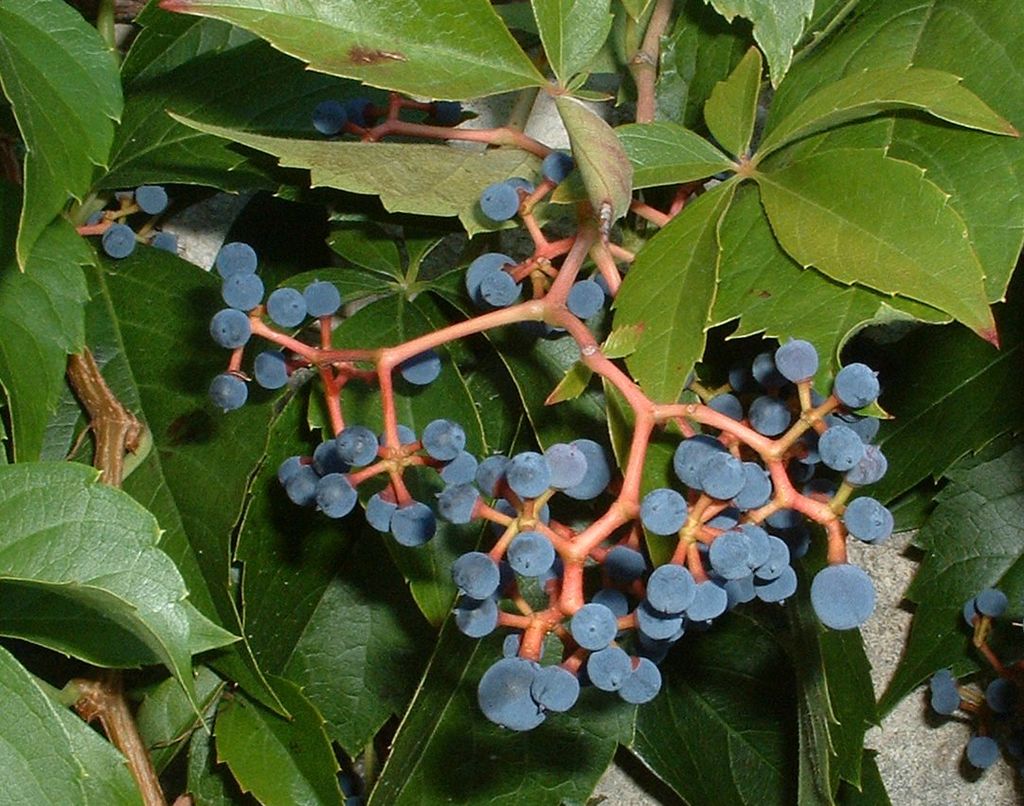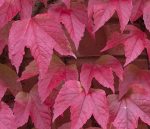
This vigorous deciduous woody vine, also known as woodbine, is native to eastern and central North America south to Mexico where it grows in a variety of habitats including forests, woods, thickets, hillsides, valleys, and rocky bluffs. It is a member of the grape family, Vitaceae, that also includes Boston ivy. Plants grow rapidly and reach 30-50′ or more. They may trail along the ground or climb by clinging to surfaces by strongly adhesive disks located at the end of the forked tendrils. The palmately compound leaves have five ovate leaflets that are 3-6″ long and have toothed margins. They are purplish in the spring, dull green in summer, and purple to crimson red in the fall. In late spring to early summer greenish white flowers appear in the upper leaf axils but are usually hidden by the foliage. They give way to small blue-black berries in the late summer that are attractive to birds but poisonous to humans if ingested. A good choice for erosion control, as a climber on trellises, arbors, fences, and other garden structure, or as a screen or cover to hide eyesores such as tree stumps. The plants are tough and tolerant of drought and urban conditions but can do considerable damage if left unchecked. Although the disks do not penetetrate mortar, they are unsightly, difficult to remove, and can damage shingles or painted surfaces. In addition, the vine may shadeout the plants that it grows over. The genus name, Parthenocissus, comes from the Greek words, parthenos, meaning virgin, and kissos, meaning ivy, and refers to the first word of its English vernacular name, Virginia creeper, honoring Queen Elizabeth I who was known as the virgin queen. The specific epithet, quinquefolia, comes from the Latin words, quinque meaning five, and folia, meaning leaf, and refers to the 5 leaflets of the compound leaves. Photo Credit Wikipedia

Type: Woody deciduous vine
Bloom: Inconspicuous greenish white flowers in late summer
Size: 30-50+’ H x 5-10′ W
Light: Full sun to partial shade but tolerates full shade; autumn leaf color best in full sun
Soil: Average, medium moist, well-drained
Hardiness: Zones 3-9
Care: Trim to control size and keep off structures that can be damaged like painted surfaces or gutters.
Pests and Diseases: Generally healthy but susceptible to canker, leaf spots, mildews, wilt; beetles, leaf hoppers and scale.
Propagation: Semi-ripe cuttings late summer, hardwood cuttings after leaf fall in late autumn to winter
Outstanding Selections:
‘Monham’ (white markings on green leaves)
Troki (bronze in spring, green in summer, red in fall)
Photo Credits:Wikipedia